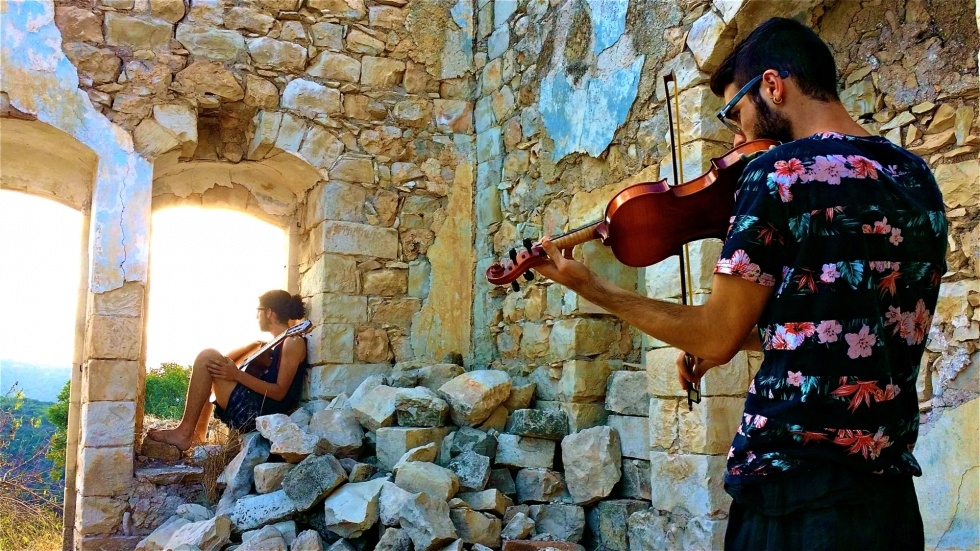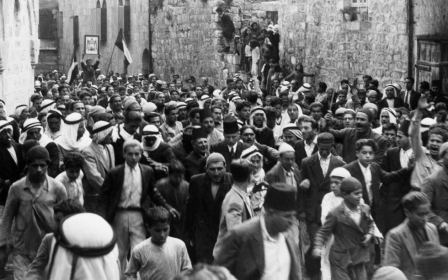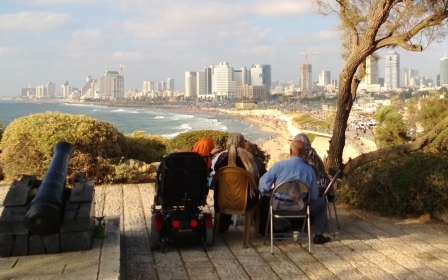Palestinians exercising the artistic right of return

KUFR BIRIM, Israel - This past weekend, artists, musicians and activists attended a workshop in Kufr Birim, a Palestinian village of beautiful, ruined stoned homes destroyed by Israel in 1953, five years after its establishment.
The name of the group responsible for the gathering is named Insiyab, Arabic for “flowing with intuition.” An artist collective, the group uses street theatre to spread knowledge about the struggles of Palestinian citizens of Israel, which number an estimated 1.7 million and face dozens of discriminatory laws, according to the Haifa-based Adalah Legal Center.
The group coordinated with al-Awda, a progressive activist group established in 1984 and consisting of descendants of those displaced from Kufr Birim by the Israeli army during the ethnic cleansing of Palestine in 1948, referred to by Palestinians as the “Nakba,” or catastrophe.
Members of al-Awda have been camping among the remains of the village since August 2013, exercising their own version of the Palestinian right of return. The right of return guarantees that Palestinians displaced would be able to return to their homes or be compensated for loss of property. It was codified in international law by United Nations resolution 194.
However, since Palestinians who remained in present-day Israel took Israeli citizenship, they are not registered as refugees. Although displaced during the Nakba, resolution 194 does not apply.
As a result of recent rise in interest concerning the activities of al-Awda, Insiyab offered to collaborate with al-Awda, offering training and exercises.
Though small in number, attendees came from across the artistic spectrum. Filmmakers, musicians, poets, actors and dancers all took part.
“People here are busy with their everyday struggle to earn a living,” Yazid Sadi, an Insiyab organiser, told Middle East Eye. “Right now, however, there is a kind of awakening taking place about the stories [surrounding the Nakba]. More and more people are starting to sympathise with the people of these villages.”
Sadi added that Kufr Birim was a natural destination for his group. “The idea is to go from one place to another through Palestine and mingle with the people, to create a connection,” he said.
A connection to the past
"During the Nakba, my grandparents were expelled from Birim when the Israeli military forced all the villagers to leave," Waad Ghantous, a 23 year old Haifa-based activist and member of al-Awda, told Middle East Eye.
Residents of Kufr Birim expected to be able to return to their homes after the war ended. "The army told them they'd be able to come back after a couple weeks,” Ghantous explained.
Soon after they were asked to leave, the people attempted to return.
“The Israeli military kept telling them they had to wait longer. After a while, it became clear that they weren't going to return to their homes. They resettled in al-Jesh," she said, referring to a nearby Palestinian town.
"My great uncle got fed up and tried to go back to his home, but soldiers shot and killed him when he arrived," Ghantous recounted.
After this and similar incidents, the residents then began a legal campaign in the newly established State of Israel. In 1953, the Israeli Supreme Court decided that the people of Kufr Birim had the right to return to their homes, unless the military put forth a good reason.
In response, the area surrounding the village was declared a closed military zone, a designation that lasts until today, and their land was divided between several Jewish communities and a national park.
In 1953, Kufr Birim was bombed by the Israeli Air Force. The only structures left standing were the church and a nearby Roman temple that attests to its long history in the area.
Often, tourists, Israeli soldiers on break, and participants in the Birthright tour, a 10-day program that takes Jewish youth through Israel in an attempt to convince them to seek Israeli citizenship, visit the site.
However, the history of Kufr Birim is not presented on any pamphlets or plaques provided by the Israeli Land Authority (ILA), the state body that administers the land.
Due to the lack of readily available information about these once vibrant communities, Palestinians who have no familial connection to these places are often unaware of their existence.
“There are more than 500, each with its own story,” Sadi said, referring to the Palestinian villages destroyed or depopulated in 1948. “The majority of these people have never been in Kufr Birim, so it was an experience for them to connect to this place.”
Samer Asakli, 23, a student activist at Haifa University, explained that while the return to Kufr Birim is important for the broader Palestinian cause, it is particularly meaningful for Palestinians in present-day Israel.
“It is about the right of return for Palestinians, but most importantly it is an issue that dates back to the original Zionist Israeli occupation of 1948,” Asakli told MEE.
“We [Palestinians in Israel] are overlooked by talk that only touches on the 1967 territories,” he added, referring to the occupied West Bank, including East Jerusalem, and the besieged Gaza Strip. “Returning to Kufr Birim can set a precedent.”
Struggles of the present
Ghantous grew up participating in cultural and political events in her ancestral home. Since al-Awda activists returned in 2013, she has taken part in their work, including the reconstruction of buildings and sleeping in shifts.
Several members of al-Awda remain in Birim constantly, often sleeping in shifts, to keep Israeli authorities at bay.
In spite of their efforts, Israeli officials from both the Land Authority (ILA) and the police have raided the activists on three occasions, confiscating personal belongings, collecting personal identification, and destroying reconstructed buildings.
The ILA and police force maintain that the activists are using the public land of the national park on which Kufr Birim now sits for private purposes.
Ghantous remains certain that she and her compatriots will return to their home. "For me, Haifa is temporary. My siblings and I grew up knowing that we will return our family home permanently.”
Kufr Birim is not the only village where efforts are being made to reclaim depopulated lands.
In the summer of 2012, activists returned to Iqrit, another Palestinian village forcibly evacuated in 1948 by the Israeli army and destroyed in 1951, with the goal of a lasting stay.
They too have experienced regular eviction and confiscation of personal belongings. It was here that Insiyab’s initiative began.
A cultural return
Sadi said that his group wants to take Palestinian culture to places where there was an attempt to erase the heritage of his people. After hearing of the activists in Iqrit, he wanted to add a cultural element to their return.
“In general, culture and art [remain] in the ‘big bubbles’ such as Haifa and Jaffa,” he explained. “We want this art to travel.”
Activities throughout the three-day event involved all of these forms of art, though the centrepiece of this particular workshop was the use of theatre. “We are mainly focused on street theatre, and we mix it with music and other arts,” Sadi continued.
For this reason, the group called on Ben Rivers to oversee the event.
Rivers, organiser of the Freedom Bus initiative of the Freedom Theatre in Jenin that sees activists and artists travel through the occupied West Bank, utilising a method known as “playback theatre” to dramatise real life experiences, shared his thoughts on the importance of theatre to the Palestinian struggle.
“When the audience watches a story re-enacted, it is able to respond on a more visceral level, a more emotional or embodied level,” he told MEE.
He contends that this emotional response is important not only for the opportunity of encouragement, but also in the act of creating an attachment that surpasses historical knowledge.
“This is important because we want people to be moved in the deepest way possible. So theatre, or any art, helps to achieve that because we’re not just relating through text or words,” he said.
Rivers states that one the important aspects of artistic expression is its ability to encourage in the face of adversity.
“When there’s this type of regular violations, it would be easy to fall into despair,” Rivers continued, commenting on the raids that the group has endured.
“I feel that, reflecting on this weekend, when a group of artists comes together, there’s a spirit of fortitude that’s strengthened.”
New MEE newsletter: Jerusalem Dispatch
Sign up to get the latest insights and analysis on Israel-Palestine, alongside Turkey Unpacked and other MEE newsletters
Middle East Eye delivers independent and unrivalled coverage and analysis of the Middle East, North Africa and beyond. To learn more about republishing this content and the associated fees, please fill out this form. More about MEE can be found here.




